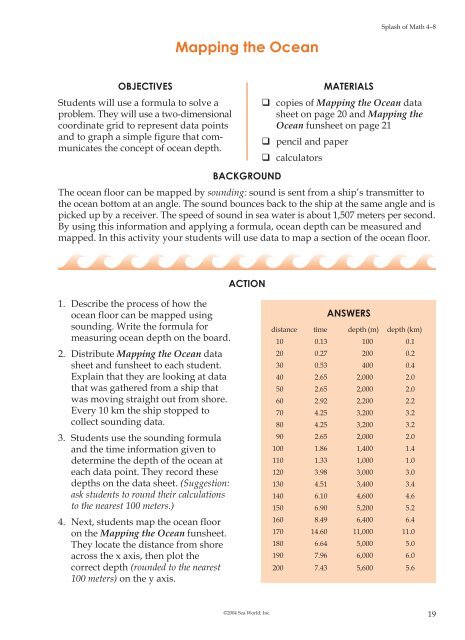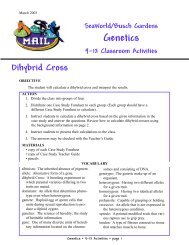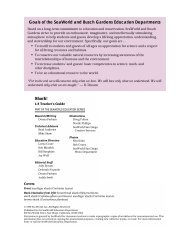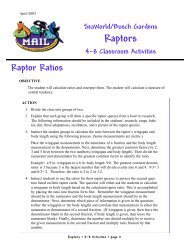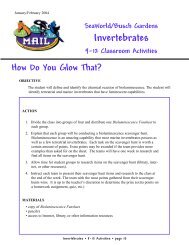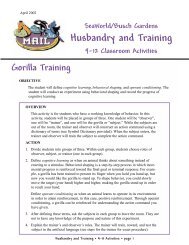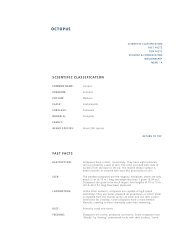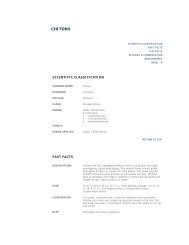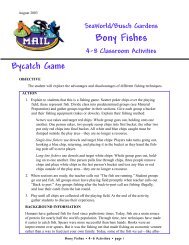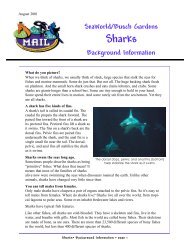Splash of Math 4–8 - Sea World
Splash of Math 4–8 - Sea World
Splash of Math 4–8 - Sea World
Create successful ePaper yourself
Turn your PDF publications into a flip-book with our unique Google optimized e-Paper software.
OBJECTIVES<br />
Students will use a formula to solve a<br />
problem. They will use a two-dimensional<br />
coordinate grid to represent data points<br />
and to graph a simple figure that communicates<br />
the concept <strong>of</strong> ocean depth.<br />
1. Describe the process <strong>of</strong> how the<br />
ocean floor can be mapped using<br />
sounding. Write the formula for<br />
measuring ocean depth on the board.<br />
2. Distribute Mapping the Ocean data<br />
sheet and funsheet to each student.<br />
Explain that they are looking at data<br />
that was gathered from a ship that<br />
was moving straight out from shore.<br />
Every 10 km the ship stopped to<br />
collect sounding data.<br />
3. Students use the sounding formula<br />
and the time information given to<br />
determine the depth <strong>of</strong> the ocean at<br />
each data point. They record these<br />
depths on the data sheet. (Suggestion:<br />
ask students to round their calculations<br />
to the nearest 100 meters.)<br />
4. Next, students map the ocean floor<br />
on the Mapping the Ocean funsheet.<br />
They locate the distance from shore<br />
across the x axis, then plot the<br />
correct depth (rounded to the nearest<br />
100 meters) on the y axis.<br />
Mapping the Ocean<br />
ACTION<br />
<strong>Splash</strong> <strong>of</strong> <strong>Math</strong> <strong>4–8</strong><br />
MATERIALS<br />
copies <strong>of</strong> Mapping the Ocean data<br />
sheet on page 20 and Mapping the<br />
Ocean funsheet on page 21<br />
pencil and paper<br />
calculators<br />
BACKGROUND<br />
The ocean floor can be mapped by sounding: sound is sent from a ship’s transmitter to<br />
the ocean bottom at an angle. The sound bounces back to the ship at the same angle and is<br />
picked up by a receiver. The speed <strong>of</strong> sound in sea water is about 1,507 meters per second.<br />
By using this information and applying a formula, ocean depth can be measured and<br />
mapped. In this activity your students will use data to map a section <strong>of</strong> the ocean floor.<br />
ANSWERS<br />
distance time depth (m) depth (km)<br />
10 0.13 100 0.1<br />
20 0.27 200 0.2<br />
30 0.53 400 0.4<br />
40 2.65 2,000 2.0<br />
50 2.65 2,000 2.0<br />
60 2.92 2,200 2.2<br />
70 4.25 3,200 3.2<br />
80 4.25 3,200 3.2<br />
90 2.65 2,000 2.0<br />
100 1.86 1,400 1.4<br />
110 1.33 1,000 1.0<br />
120 3.98 3,000 3.0<br />
130 4.51 3,400 3.4<br />
140 6.10 4,600 4.6<br />
150 6.90 5,200 5.2<br />
160 8.49 6,400 6.4<br />
170 14.60 11,000 11.0<br />
180 6.64 5,000 5.0<br />
190 7.96 6,000 6.0<br />
200 7.43 5,600 5.6<br />
©2004 <strong>Sea</strong> <strong>World</strong>, Inc. 19


